|

Huaiyang Chinese Pastry 淮揚酥皮
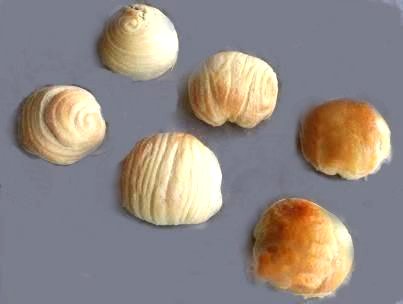
There are two main types of layered Chinese Flaky Pastry,
1. The Huaiyang method (淮揚酥皮)
2 The Dim Sum method (廣式擘酥).
Pastry
made with Huaiyang method pastry are more common and can be
found in streets and shops, whereas the Dim sum-style pastry are more of a speciality and usually only found in dim sum
restaurants.
The Huaiyang method flaky pastry is the generic layer found in
Chinese pastry. It is also
easier and quicker to make than the Dim Sum method. The
Dim Sum method flaky pastry is more comparable to the western puff
pastry where it is more time consuming to prepare.
The Huaiyang method (淮揚酥皮)
The pastry is basically made up of two separate dough,
1.The water dough (水油麵皮)
2.The other the lard or
shortened dough (油酥麵皮).
The basic water dough consists of flour,
water and lard in the proportion of roughly 5 : 2-2.5 : 1-1.25
depending on recipes. In some recipes, a little bit of sugar or salt
is added for flavour, but traditionally no flavouring is added.
Although lard is the traditional fat used, shortening, butter
or margarine, or even liquid cooking oil could also be used instead
of lard. The lard dough consists of
flour and lard in the proportion of roughly 2 : 1.
After the water dough and lard dough are mixed separately, the lard
dough is wrapped inside the water dough, then the combined dough is
layered by rolling and folding similar to making puff pastry.
Two
methods are used to accomplish the layering of the dough, the
large-scale method (大包酥) or the small-scale method (小包酥). The
large-scale method is quick and able to produce a larger quantity in
a shorter time frame but the resultant layers are not as distinct
and delicate. The small-scale method is slow and more suitable for
preparation in domestic homes in small quantity, but it produces a
more distinct and delicate layering effect.
.
Once the layering is done, the resultant dough pieces can be used to
produce three different types of shaping
1. Hidden layering (暗酥)
2 Half-hidden layering (半暗酥)
3. Visible layering (明酥).
With the hidden layering, the layering cannot be seen on the outside
of the end product, as the layering is in the cross-section. This is
the easiest and most common method for beginners.
The half-hidden layering is one where only half of the layering is
visible on the outside of the end product.
As the name implies, the visible layering is one where the layering
can be seen on the outside of the end product. Within the visible
layering, there are spiral layering (圓酥) and parallel layering (直酥).
Home Method (small scale)

1. First make the water dough and lard dough separately according to
recipe. Divide the water dough and lard dough into small equal
portions according to the recipe. Take a piece of water dough and a
piece of lard dough. Roll out the water dough into a flat circle.
Place the rounded lard dough in the centre of the flat circle.
2. Gather the outer edges of the water dough circle and wrap up the
lard dough ball.
3. Pinch and seal the edges.
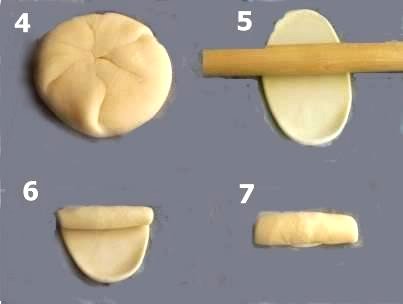
4. With the heel of your palm, gently press the dough down to
flatten it lightly.
5. Using a small rolling pin, roll out the dough.
6. Roll the dough up Swiss-roll style.( Make sure you roll it
tight)
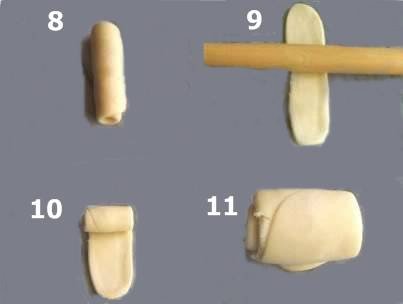
8. Turn the rolled dough 90 degrees.
9. Roll out the dough again.
10. Roll up Swiss-roll style again
11. Cover the dough and rest for 15 minutes and then it is ready for
filling and shaping.
Technique for Hidden Layering shaping 暗酥
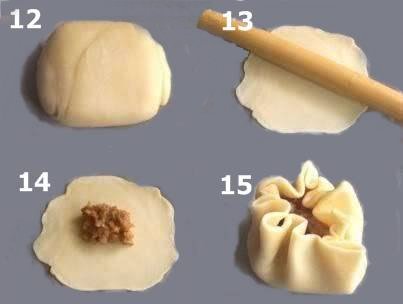
12. With the heel of your palm, gently press the dough down to
flatten it lightly.
13. Roll out the dough.
14. Place filling in the centre.
15. Gather the outer edges of the dough circle and wrap up the
filling.
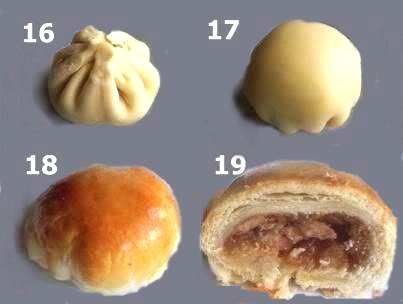
16. Pinch and seal the edges making sure the seal is tight.
(This is
ready for baking if the recipe calls for pau shape.)
17. Turn the dough upside down so the sealed end is underneath.
18. Egg wash the surface if desired and bake or deep-fry according
to recipe.
Technique for Visible Layering – Spiral (Escargot) shaping 圓酥
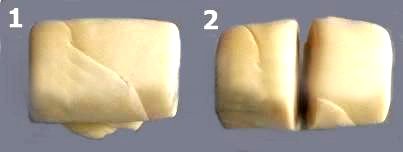
1. Proceed with Technique for Making Chinese Flaky Pastry using
Small-Scale Method up to step 11.
2. Cut the dough crosswise
into two pieces. ( just like slicing a round bun)
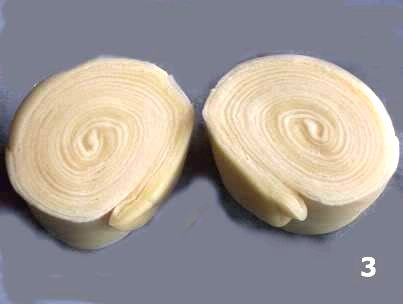
3. The cut surface reveals the spiral layering.

4. Turn the dough so the cut surface is facing downward.
5. With the heel of your palm, gently press the dough down
to
flatten it lightly.
6. Roll out the dough.
7. Place filling in the centre.

8. Gather the outer edges of the dough circle and wrap up the
filling.
9. Pinch and seal the edges making sure the seal is tight.
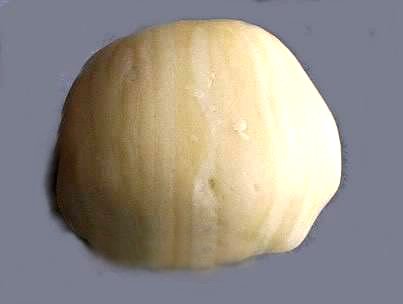
10. Turn the dough upside down so the sealed end is underneath.
Bake
or deep-fry according to recipe (do not egg wash as it
will destroy
the layering effect).

Baked Spiral-Layering Pastry. (horizontal across)
Technique for Visible Layering – Parallel shaping 直酥
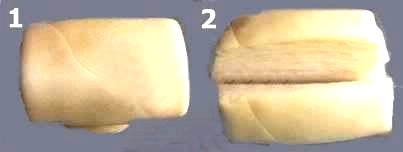
1. Proceed with Technique for Making Chinese Flaky Pastry using
Small-Scale Method up to step 11.
2. Cut the dough lengthways into two pieces.
( just like slicing a sausage or hot dog bun)
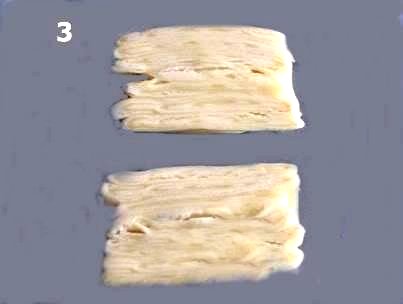
3. The cut surface reveals the parallel layering.
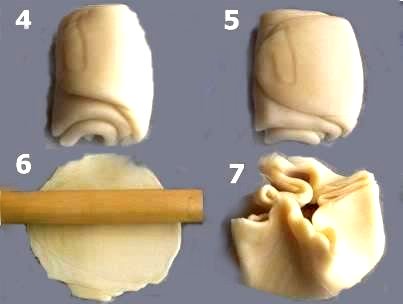
4. Turn the dough so the cut surface is facing downward.
5. With the heel of your palm, gently press the dough down to
flatten it lightly.
6. Roll out the dough.
7. Place filling in the centre. Gather the outer edges of the dough
circle
and wrap up the filling.
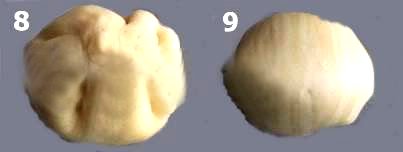
8. Pinch and seal the edges making sure the seal is tight.
9. Turn the dough upside down so the sealed end is underneath.
Bake
or deep-fry according to recipe (do not egg wash as it will
destroy
the layering effect).
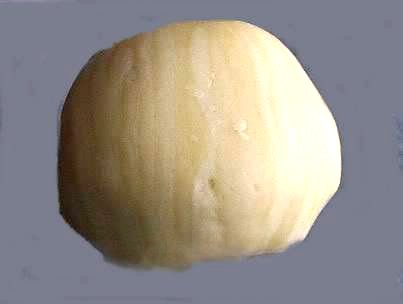
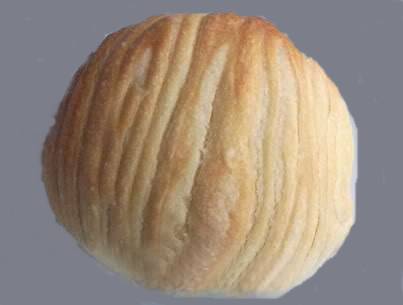
Baked Parallel-Layering Pastry. (Vertical down)
The Large Scale Method(大包酥)
1. For the water dough: put flour, salt, sugar and ghee in a
mixing bowl, slowly add just enough water to form a soft but
non-sticky dough. Knead until smooth, form into a ball, cover and
put into the refrigerator for about 20 minutes before using.
2. For the short dough (oil based): mix all ingredients and knead into a soft
dough. If it is too soft, chill in the refrigerator to harden a bit.
If it is too hard, knead it a bit more until you get soft dough
about the same flexibility as the water dough. It is important that
the pliability of the short dough should be about the same as the
water dough when making the spiral pastry.
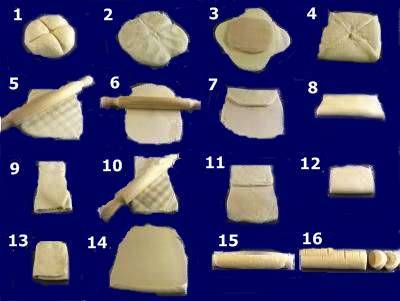
3. Take the water dough out from the fridge, knead briefly and
form into a ball. Cut a cross halfway through the dough ( no1). Press
the four quarters of the dough out (no 2) and pin it out into a sheet
using a rolling pin. Put the short dough, shape into a rough square
to fit, in the middle of the pin-out water dough (no 3). Fold the
overlapped water dough to enclose the short dough, seal the edges
(no 4). With the rolling pin, press down the dough in a crisscross
fashion to flatten the dough (no 5) then roll it out ( no 6). Fold the
top 1/3 of the dough down ( no 7) and the bottom 1/3 up to get three
layers (no 8). Turn the 3-layer dough 90° ( no 9) and repeat the
pressing, rolling and layering process (no10, 11, 12 and 13) three
more times. Press the dough down in the crisscross fashion again and
pin it out to get a thin rectangular sheet ( no14) or trim the edges
to get a perfect rectangle. Roll it up Swiss roll style and
divide the roll into 24 portions.
4. Take 2 portions of the finished dough, flatten with your palm and
roll them out into 2 spiral discs respectively. Put about one heaped
tablespoon of the filling in the middle of one of the disc and cover
it with the other disc, making sure the side with the clearer spiral
lines is facing outward. Pinch and seal the edges, with the aid of a
little water if necessary. With your thumb and forefinger, work
along the edges by pinching and folding a rope edge all the way
around. Repeat with the rest of the dough pieces and filling.
Back to Recipes Index
|



















